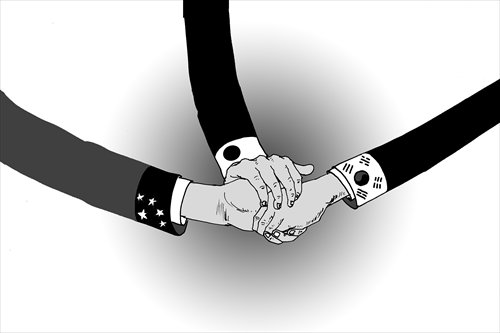Trilateral agreement will create stable regional market

Illustration: Luo Xuan/GT
The China-Japan-South Korea trilateral free trade talks have shown signs of critical progress, laying the groundwork for the creation of a common market between the three pivotal Asian economies.
Steps forward have been made at the 10th round of trilateral free trade talks between China, Japan and South Korea, which wrapped up on June 28 in Seoul. The three nations have agreed on the areas to be covered in the trilateral free trade agreement (FTA), and agreed to deal with five topics including financial services, telecoms, and movement of natural persons through the formation of subordinate working groups. They also decided to exchange information on market entry barriers in important services sectors.
However, differences have occurred regarding trade tariffs. Japan and South Korea demanded greater trade liberalization, while China was more concerned about protecting domestic industries and thus was cautious about cutting relevant tariffs. Future negotiations are expected to face more direct collisions and conflicts of interest, however, the FTA will still enter a phase of material progress.
During the post-crisis period, new changes have emerged amid current globalization. As the Doha Round multilateral trade talks under the framework of the WTO have stalled, the mechanism of regional FTAs has become the new choice for the global markets. As major economic powers grow anxious about the world economy's current predicament of "new mediocre" growth, free trade has become increasingly affected by trade protectionism, and regional FTAs have been seen as serving geopolitical interests. For instance, in the US-led Trans-Pacific Partnership (TPP), US President Barack Obama said that the US, not China, should set the rules for economic engagement in the Asia-Pacific region. The slow progress of the trilateral FTA has reflected some other disturbances such as Japan's views on history and Japan's anxiety over a rising China, which have rendered the country short-sighted over the FTA issue. What's more concerning is that Japan would rather join the US-led TPP than push forward the trilateral FTA in order to counter China's rising presence.
These difficulties have meant that instead of achieving a trilateral FTA, bilateral FTAs have moved ahead instead - with little success. The negotiations of the Japan-South Korea FTA have been uneasy and the China-Japan FTA is languishing without even a feasibility study. Besides, there are also technical difficulties in establishing trilateral treaties without building bilateral treaties first. But the current situation of global trend, geo-economics and market development require the trilateral FTA to leap ahead.
The establishment of the trilateral FTA will truly advance the trade and economic integration of East Asia and the Asia-Pacific region, otherwise, free trade zones (FTZs) within the region will remain divided and geo-economic conflicts are likely to escalate into geopolitical ones. In addition, China, Japan and South Korea are among the world's largest economies both in economic scale and trade volume, but the proportion of their trade which is conducted with each other is believed to be below 20 percent. Past experience from the EU and the North American Free Trade Agreement has demonstrated that the formation of a single market will advance a country's capability to withstand market risks and achieve even greater benefits.
Despite the historical difficulties, tough realities and intervention of the US, the meetings of the three countries' leaders have become normalized, and the trilateral negotiations have entered a crucial stage. China, Japan and South Asia should make joint efforts to clear the obstacles to achieve a common market through the trilateral FTA.
The author is a research fellow with the Charhar Institute, a non-governmental think tank. bizopinion@globaltimes.com.cn